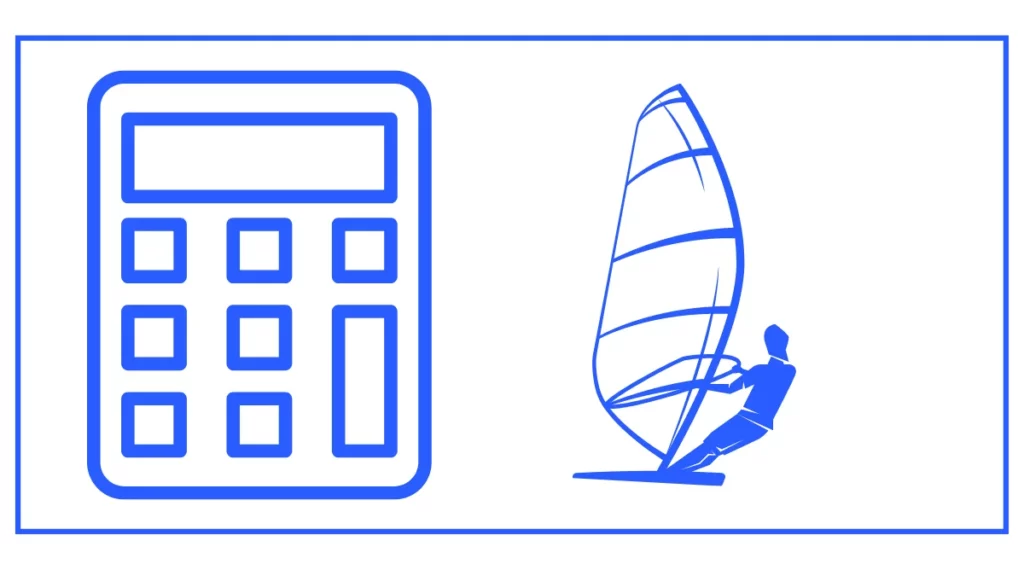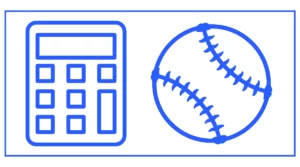Windsurfing Calculator
The windsurfing calculator helps you calculate the perfect board and sail size depending on your weight and wind speed.
Enter your weight ( The max limit is 120kg) and the wind speed ( maximum 22 knots).
The results show the suggestions for beginner and intermediate boards with all parameters like volume, length, and width. Moreover, you can also calculate the sail size.

You might want to calculate elliptical calories, Kiteboarding Calories, or Baseball whip.
A windsurfing calculator is an invaluable tool for both beginners and experienced windsurfers. It helps determine the ideal sail size and board dimensions based on factors such as your weight, skill level, and wind conditions. By using a windsurfing calculator, you can ensure that you’re using equipment that’s well-suited to your needs, which can significantly enhance your performance and enjoyment on the water.
How our Windsurfing Calculator Works
Most windsurfing calculators take into account several key factors:
- Rider Weight: Your body weight plays a crucial role in determining the appropriate board volume and sail size.
- Wind Speed: The current wind conditions greatly influence the sail size you should use.
- Skill Level: Beginners typically need larger, more stable boards and smaller sails compared to advanced riders.
By inputting these variables, the calculator provides recommendations for board size (volume, length, and width) and sail size.
Choosing the Right Windsurf Board
Selecting the appropriate windsurf board is essential for a successful and enjoyable experience on the water. Let’s look at how a windsurfing calculator can help you make this choice.
Board Volume
The volume of a windsurf board, measured in liters, is a critical factor in determining its buoyancy and stability. A windsurfing calculator typically recommends board volumes based on your weight and skill level.
For example:
- A beginner weighing 70 kg might be recommended a board with a volume of around 175 liters.
- An intermediate rider of the same weight might be advised to use a board with a volume of about 121 liters.
Board Length and Width
The length and width of the board affect its performance characteristics. Longer and wider boards are generally more stable and better suited for beginners, while shorter and narrower boards offer more maneuverability for advanced riders.
A windsurfing calculator might suggest:
- For a 70 kg beginner: A board length of 299 cm and width of 83 cm
- For a 70 kg intermediate rider: A board length of 269 cm and width of 75 cm
Selecting the Right Windsurf Sail
The sail is your engine on the water, and choosing the right size is crucial for optimal performance. A windsurfing calculator takes into account your weight and the wind speed to recommend an appropriate sail size.
Sail Size Recommendations
Sail sizes are typically measured in square meters (m²). The calculator provides recommendations based on your weight and the current wind speed. For instance:
- A 70 kg rider in 10-knot winds might be recommended a 9.4 m² sail
- The same rider in 20-knot winds might be advised to use a 4.8 m² sail
Remember, these are general guidelines. Your personal preferences and skill level also play a role in sail selection.
The Importance of Fin Selection
While most windsurfing calculators focus on board and sail size, it’s worth noting the importance of fin selection. The fin affects your board’s stability, speed, and maneuverability.
Fin Size Considerations
Fin size is typically proportional to sail size. Larger sails generally require larger fins to maintain control. While a windsurfing calculator might not provide specific fin size recommendations, keep these general guidelines in mind:
- For sails up to 6.5 m², a fin around 28-32 cm is usually suitable
- For sails between 6.5-8.0 m², consider fins in the 34-38 cm range
- For sails over 8.0 m², fins 40 cm and above are often appropriate
Windsurfing in Different Wind Conditions
Wind conditions play a crucial role in windsurfing, and a good windsurfing calculator takes this into account. Let’s explore how wind speed affects your equipment choices.
Light Wind Conditions
In light winds (usually considered below 10 knots), you’ll need larger sails to generate enough power to plane. A windsurfing calculator might recommend:
- For a 70 kg rider in 7-knot winds: A 12.5 m² sail
Larger sails require more strength to maneuver, so beginners should be cautious in these conditions.
Moderate Wind Conditions
Moderate winds (10-15 knots) are often ideal for windsurfing. In these conditions, a windsurfing calculator might suggest:
- For a 70 kg rider in 13-knot winds: A 7.1 m² sail
Strong Wind Conditions
In strong winds (over 20 knots), smaller sails are necessary for control. A windsurfing calculator might recommend:
- For a 70 kg rider in 25-knot winds: A 4.0 m² sail
Remember, these are general guidelines. Always consider your skill level and comfort when choosing equipment for strong wind conditions.
Windsurfing Calculator for Beginners
If you’re new to windsurfing, a windsurfing calculator can be particularly helpful. It takes the guesswork out of equipment selection, allowing you to focus on learning the sport.
Beginner Board Recommendations
For beginners, stability is key. A windsurfing calculator typically recommends boards with:
- Higher volume for better flotation
- Wider width for increased stability
- Longer length for easier planing
Many beginner boards also feature a daggerboard, which helps with upwind sailing and stability.
Beginner Sail Recommendations
For novice windsurfers, the calculator usually suggests smaller sails that are easier to handle. It’s better to start with a sail that feels a bit small than one that overpowers you.
Advanced Windsurfing Calculators
As you progress in your windsurfing journey, you might find more advanced calculators that take into account additional factors:
- Specific windsurfing disciplines (freeride, slalom, freestyle)
- Board shape and construction
- Sail material and design
- Fin type and size
These advanced calculators can help fine-tune your equipment choices as you become more experienced.
The Limitations of Windsurfing Calculators
While windsurfing calculators are incredibly useful tools, it’s important to understand their limitations:
- They provide general guidelines, not absolute rules.
- They can’t account for personal preferences or local conditions.
- They may not consider factors like wave conditions or water temperature.
Always use a windsurfing calculator as a starting point, and adjust based on your experience and local knowledge.
Windsurfing Calculator vs. Experience
While a windsurfing calculator is an excellent tool, especially for beginners, it’s not a substitute for experience. As you spend more time on the water, you’ll develop a feel for what equipment works best for you in various conditions.
As you progress, you’ll likely build a quiver of different boards and sails to suit various conditions. A windsurfing calculator can help guide these purchases, ensuring you have appropriate equipment for a range of wind speeds.





